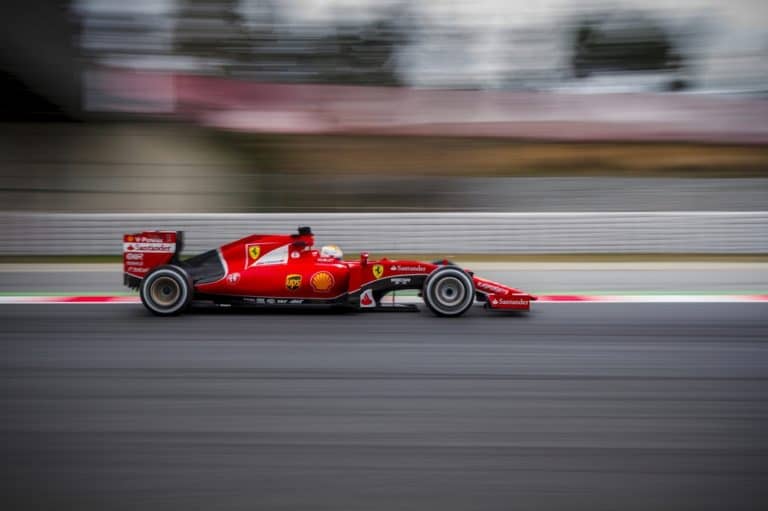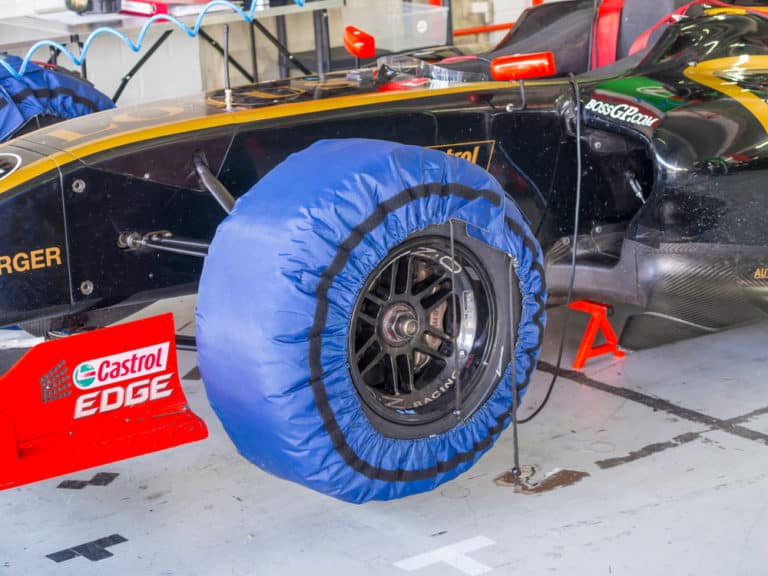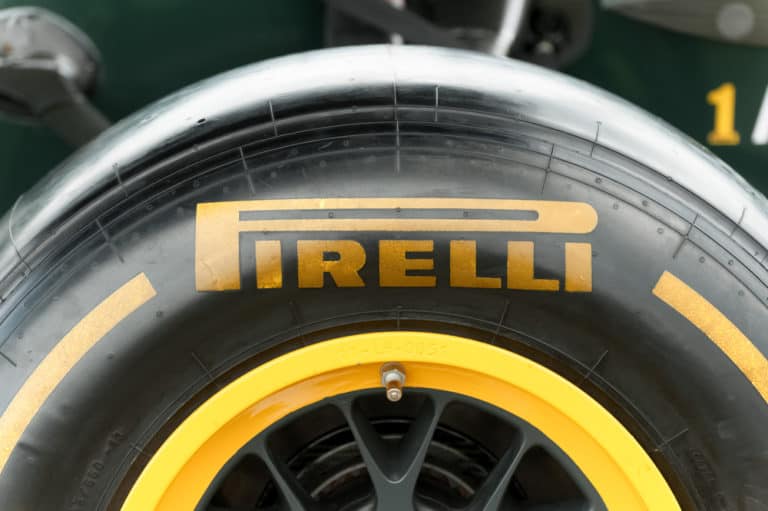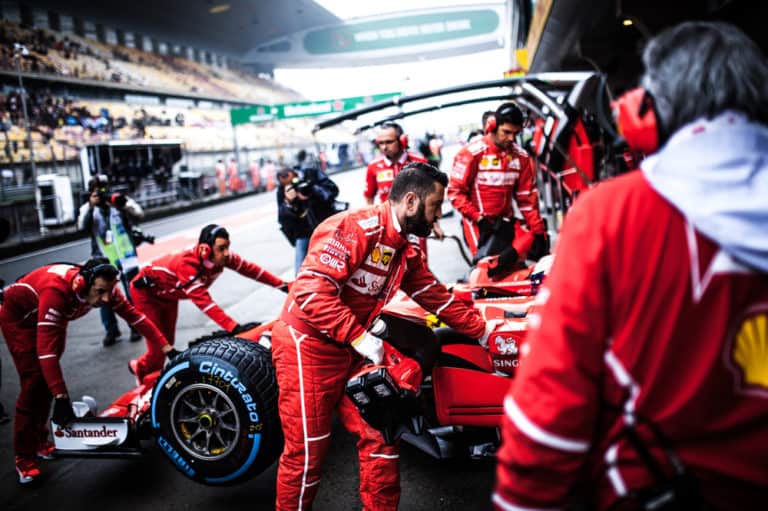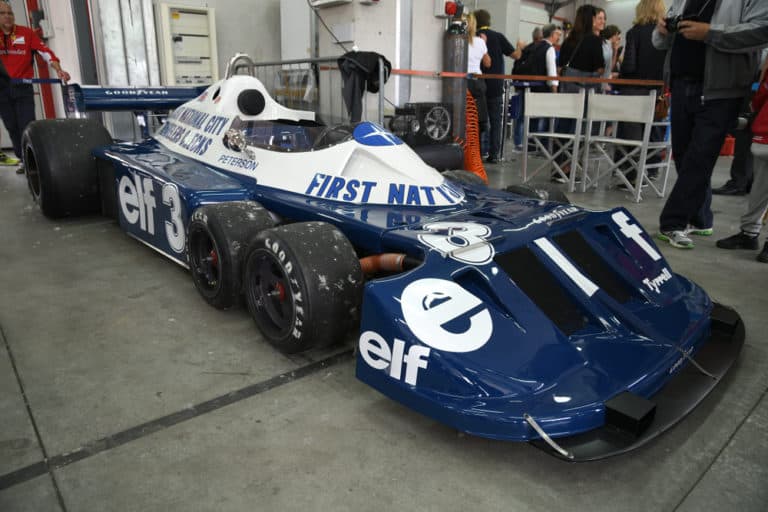Have you ever been watching an F1 race and been confused by all the flags waved by the marshals during the race? I decided to do some investigating and find out how many different flags can be shown during a Formula 1 session and what they all mean. It turns out there are many more than I expected and that some of them are barely ever used. So, what do all the flags in Formula 1 mean?
Each flag used in F1 has a different meaning. Red means the session is suspended, yellow means there is a hazard on the track, green means racing can resume, and blue means a faster driver is approaching a backmarker who must move aside. A black flag means a driver is disqualified.
There are many more flags used in Formula 1 that haven’t been mentioned above. You can read on to find out what those are, what they mean, and find out more details about the ones already mentioned. The history of some of the flags used is fascinating, and some instances when specific flags have been used will likely surprise you. Just make sure you aren’t too slow when you read this; otherwise, you might just be shown a black flag.
If you’re looking for some F1 merchandise, check out the awesome stuff at the official F1 store here.
What Do The Flags in F1 Mean?
| Flag Colour/Type | Meaning |
| Yellow | Hazard on track. |
| Green | Normal racing conditions apply. |
| Red | Session is suspended. |
| Blue | A faster car is approaching. Move aside (when a driver is being lapped). |
| Yellow & Red Stripes | Track is slippery. |
| Black With An Orange Circle | A driver has a mechanical issue and must return to the pits. |
| Black & White | Warning for unsportsmanlike behavior. |
| Black | Disqualification. |
| White | Slower moving vehicles ahead, or miscellaneous vehicles on the track. |
| Chequered | The session is finished (no new laps may be started). |
What Do Yellow Flags Mean in F1?
Yellow flags indicate that there is a hazard on the track. This hazard might be a car that has gone into the barriers or off the track or debris somewhere on the racetrack. Drivers must reduce speed under yellow flag conditions and are not allowed to overtake.
If a yellow flag is waved during qualifying, drivers must abandon their flying laps. This can sometimes seriously compromise a driver’s qualifying session, especially if they are on their final flying lap before the qualifying session ends.
Yellow flags will always be waved by the marshals immediately after an incident, which means that drivers will reduce their speed as they could potentially endanger themselves or others. Sometimes, if the incident is bad and requires a lot of work to get back to safe racing conditions, a red flag will be waved after the yellow flags have been waved. But you will have to read on to the next section to find out more about red flags.
Yellow flags are usually accompanied by a safety car if the disruption is significant. The safety car will usually be deployed if there is a car that has come to a stop off the track but is in a position where the marshals can easily remove it without endangering their safety or the safety of the drivers.
There are two types of yellow flags: single waved yellow flags, and double waved yellow flags, each meaning a different thing.
What Do Single Waved Yellow Flags Mean?
A single waved yellow flag during F1 means that overtaking is prohibited, and therefore, cars must slow down because there is a danger on the track. This may be debris from another car or if another car has gone off the track and is either waiting to re-join or is stuck in the gravel or the barriers.
What Do Double Waved Yellow Flags Mean?
A double waved yellow flag during F1 means that overtaking is prohibited, and therefore, cars must slow down because something is blocking the track. An excellent example of this was the 2019 Monaco Grand Prix, where George Russell was blocking a large section of one of the corners on the street circuit. His car was horizontal across the track, and therefore, double waved yellow flags were brought out to warn drivers of the impending danger.
What Do Green Flags Mean in F1?
A green flag in Formula 1 means that normal racing conditions apply. This means that drivers can race each other (which means they’re allowed to overtake) and drive without any concerns related to hazards on track.
A green flag is waved at the start of each race when the lights go out to indicate the race has started and that normal racing conditions are in place. While this may seem obvious at the start of the race, sometimes, due to inclement weather, the race will start under a safety car, and therefore, normal racing conditions do not apply. This is because, under a safety car, drivers must reduce speed and maintain position, so no overtaking is allowed.
A green flag will also be shown after a yellow flag to indicate that the hazard impeding racing has been removed and that it is safe to race again. There will be a green flag waved at each marshal station for the duration of the lap after the yellow flag conditions have ended.
What Do Red Flags Mean in F1?
If a red flag is waved during a Formula 1 race, qualifying session, or practice session, it means that the session is immediately stopped. It is waved due to imminent danger to the drivers or spectators. Drivers must significantly reduce their speed and make their way back to the pitlane.
Red flags are often waved after a big crash, where the car is stuck in the barriers and needs to be removed. A car in the barriers poses a safety hazard to the drivers on track, the driver who had an accident, and the marshals who have to free the car from the barriers. Therefore, the session will be red-flagged to ensure that the safety of anyone involved is not compromised.
If it is due to an accident, the red flag conditions will last for as long as it is necessary to remove the stricken car and repair the barriers adequately. Repairing the barriers is essential because compromised barriers can seriously affect the safety of the drivers still racing.
When the race is red-flagged due to adverse weather, the length of the delay depends on how long the bad weather hangs around the track and, after this, whether the track is safe to race on.
During red flag conditions, teams are allowed to repair their cars. However, there are some conditions attached to these repairs. They cannot change the type of parts used. Therefore, everything that is replaced needs to be replaced with something of the exact specifications and approved by the race officials. These repairs will not be penalized. Teams can also change their tires during the red flag conditions.
If drivers are unable to line up in the pitlane in their race order, they will be given a chance to restore themselves to the correct order before the race is restarted. This usually involves cars that have been lapped making their way ahead of the frontrunners so they can get to the back of the pack. After a red flag, the race will either resume with a safety car restart, where drivers will stay behind the safety car for a lap before racing resumes, or they will perform a standing start on the grid as if they were starting the race for the first time.
In the case of a red flag stoppage during a Formula 1 race, the red flag cannot exceed three hours, and the race itself, excluding the time under the red flag, can’t be any longer than two hours. Furthermore, teams and drivers are given a 10-minute warning before the race is set to resume to make sure that they have enough time to remove all equipment and personal from around the car and get the driver back into the car.
However, if a red flag is brought out during a free practice session in a Formula 1 race weekend, the session is stopped, but the clock is not. Therefore, a lengthy delay due to a red flag can significantly curtail the number of times drivers get to spend on the track during a free practice session.
What Do Blue Flags Mean in F1?
Blue flags are waved during an F1 race when a driver is being lapped by another driver who is traveling at a higher speed. The slower car that is being lapped must let the other car past without impeding them. They must do this; otherwise, they will receive an official warning for not respecting blue flags. Drivers are shown a maximum of three blue flags before being penalized.
Blue flags are also used during qualifying and practice sessions to warn drivers of another driver approaching at a faster speed. The quicker driver will be on what is called a flying lap, so the drivers not on their flying laps must move aside so as not to impede the other driver.
More information regarding blue flags will be communicated to drivers over the radio by their race engineers. This is about how close the approaching car is, so drivers know when to expect the faster car so that they can move aside in a timely and safe manner.
Drivers who are lapping other drivers are also allowed to use DRS to help them pass more efficiently when a blue flag is shown to the car they are lapping.
Furthermore, blue flags are also shown to drivers who are leaving the pit lane to warn them of a faster car approaching the racing line.
What Does a Yellow and Red Striped Flag Mean in F1?
A yellow and red vertically striped flag is used to warn F1 drivers that the track is slippery. The most common causes of the slippery track are water and/or oil. This flag will also be used to indicate to drivers of a small animal on track. In this case, it will be rocked from side to side rather than waved.
The occurrence of small animals on the racetrack during a Formula 1 race is more common than you think. During the 2020 Bahrain Grand Prix, a dog made its way onto the circuit during Free Practice 2, and during the 2016 Canadian Grand Prix, there were a pair of seagulls that had landed on the track. However, in the case of the 2020 Bahrain Grand Prix, the session was red-flagged to ensure the animal’s safety.
What Does a Black Flag with an Orange Circle Mean in F1?
A black flag with an orange circle indicates that a driver has a mechanical problem with their car, and they must immediately return to the pitlane. If this flag is waved, it will be accompanied by the driver’s number to indicate to the specific driver that the issue is with their car.
What Does a Black and White Flag Mean in F1?
A black and white diagonally split flag is used to warn drivers of unsportsmanlike behavior that could lead to them receiving a penalty from the race stewards. FIA race director Michael Masi has said that the black and white flag is like a yellow card in football. It is a warning to drivers that they have done something illegal but not bad enough to be punished.
If drivers disregard track limits three times during a Formula 1 race, they will be shown a black and white flag. Track limits are specific to the racetrack itself, but the general rule is that a driver cannot have all four wheels outside the outer edge of the curb. If a driver breaks track limits during a lap, they will have that lap time deleted because they were seen to have gained an unfair advantage by going off the track. If track limits are violated on the final corner of a track, not only will that lap time be deleted, but the lap time of the next lap will also not count as going wide on the final corner is seen to give drivers an advantage for their next lap.
Formula 1 drivers are only shown one black and white flag during a race before the stewards will likely issue them with a time penalty. In the case of disregarding track limits, a black and white flag will be shown for the fourth violation during a race. If track limits are not adhered to for the fifth time, drivers will receive a five-second time penalty.
Drivers must be warned about being given a black and white flag because if they are unaware and break more rules, they can receive a time penalty that could significantly hinder their race.
Black and white flags went out of use in Formula 1 for a while because former FIA race director Charlie Whiting preferred to warn drivers over the radio about their on-track infringements. However, they came back into use after Michael Masi was promoted to race director following Whiting’s death in March 2019. Masi said he preferred using the black and white flags as they were a more transparent warning system. So, for the first time since 2010, black and white flags were used again during the 2019 Belgian Grand Prix hosted at the Circuit de Spa-Francorchamps.

What Does a Black Flag Mean in F1?
A black flag is a flag that any Formula 1 driver does not want to see. If a driver is shown a black flag, it means that they have been disqualified and must immediately return to their pits. Their race is over once a black flag has been shown to them.
While black flags are usually shown for extremely unsafe behavior, there are other circumstances where they can be displayed. In 1969 during the Canadian Grand Prix, Al Pease was shown a black flag for being too slow. When he was disqualified, he had completed only 22 laps, whereas the leaders of the race had already finished 46 laps. Therefore, the stewards disqualified him as they deemed him to pose a danger to other drivers.
Another crazy example of a black flag was during the 1977 German Grand Prix. Driver Hans Heyer had failed to qualify for the race. However, because he knew some of the marshals on a personal level, he managed to pull some strings that allowed him to sneak onto the starting grid. Unfortunately for Heyer, he had to retire during the race because he had a problem with his gearbox. This drew the attention of the race stewards, who realized what he had done, and they immediately disqualified him from the race.
Black flags are shown extremely infrequently in Formula 1, and the last time a driver was black-flagged was during the 2007 Canadian Grand Prix in Montreal. Both Filipe Massa and Giancarlo Fisichella were shown black flags during the race for leaving the pit lane when the red light at the end of the pit lane was still on. This red light is used to control the exit of drivers from the pitlane, and when it is on, drivers are not allowed onto the race track until it is turned off.
What Does a White Flag Mean In F1?
A white flag is used to warn drivers of slow-moving vehicles on the track ahead or if there is a miscellaneous vehicle on the track. White flags are usually used at the end of free practice sessions to warn drivers coming around the final corners that drivers at the start/finish line are practicing their starts in anticipation of the upcoming race.
What Does a Chequered Flag Mean in F1?
The chequered flag in Formula 1 indicates that the race is finished or that the practice or qualifying session is completed. Once the chequered flag has been waved, drivers are unable to start a new lap, but they are allowed to finish a lap that they began before the chequered flag.
It is a black and white and chequered flag with equal black and white squares. Recently, fans have been able to enter competitions to get their name on one of the squares on the chequered flag waved at the end of an F1 race.
Sometimes, the chequered flag will be waved by a special guest, usually a celebrity. For example, at the 2021 Italian Grand Prix hosted at Monza, Italian sprinter and men’s 100m gold medallist Lamont Marcell Jacobs waved the chequered flag at the end of the race.
How Are Flags Communicated to Drivers in F1?
It is vital that F1 drivers immediately know what flags are being waved and what the issue is. It is fundamental to their safety and the safety of the other drivers and marshals, especially if it is a red or yellow flag. Drivers need to know where the safety hazard is and that they need to reduce their speed.
However, Formula 1 is an extremely fast-paced sport, so when drivers are flying around the track at over 180 miles per hour, it is sometimes difficult to notice the flags being waved by the marshals. Therefore, the flags are communicated to drivers in multiple ways. They are obviously physically waved by marshals at different points along the track. The steering wheels in F1 cars also have a section of lights that will light up in different colors to indicate a red or a yellow flag.
Furthermore, the drivers will be alerted to the flags by their race engineers. This will also come with more information about the nature of the incident and instructions about what to do next. This is particularly important when a race is red-flagged as drivers need to know when to return to the pitlane and about any other essential pieces of information.
Conclusion
Flags form a vital part of Formula 1, as they are used to warn drivers about any dangers on the track and communicate with them in an easy-to-understand way. Each flag has a specific meaning, and they all perform a crucial function. However, some are used much more often than others, with blue flags, green flags, and of course, the chequered flag making an appearance at every race on the calendar. Yellow flags are also extremely common, as it is highly likely that a driver will go off the track at some point during the race weekend.
References
- https://racingnews365.com/what-are-f1-track-limits-and-how-do-they-work
- https://www.skysports.com/f1/news/12433/11811224/f1s-black-and-white-flag-explaining-racings-yellow-card-for-drivers
- https://www.autosport.com/f1/news/black-and-white-flag-becomes-f1s-official-yellow-card-warning-4989221/4989221/
- https://f1.fandom.com/wiki/Flag_system
- https://www.sportskeeda.com/f1/f1-steering-wheel
- http://news.bbc.co.uk/sport1/shared/spl/hi/motorsport/03/formula_one/flags/html/flags.stm
- https://www.sportskeeda.com/f1/racing-flags-f1
- https://www.mclaren.com/racing/f1-playbook/red-flag/
- https://www.motorsportweek.com/2020/12/17/fia-reduces-maximum-f1-race-time-to-three-hours/

